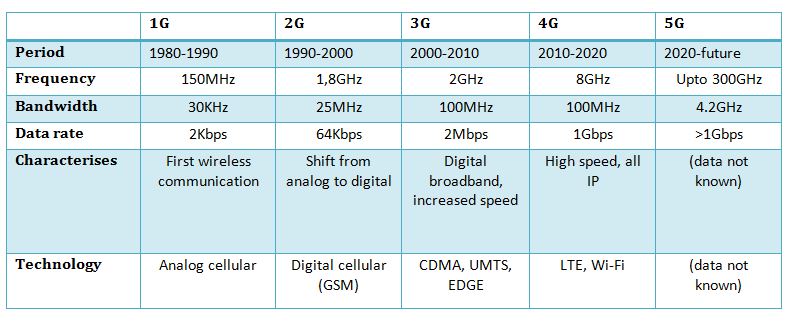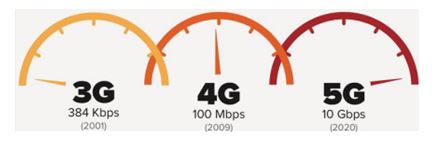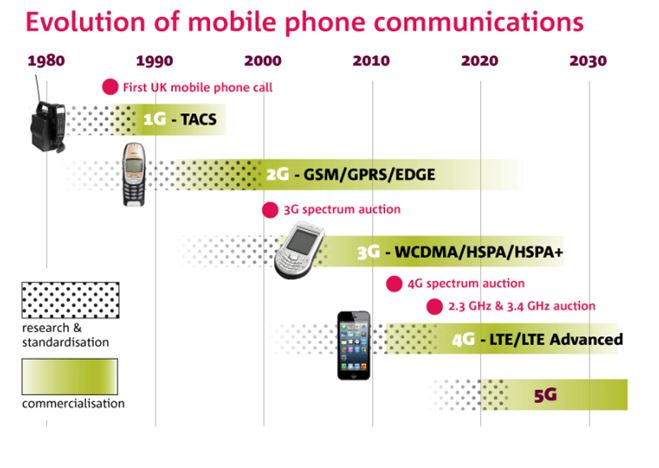What is a wireless telecommunication network?
In simple terms, it may be defined as a wireless network which enables us to communicate over mobile phones and similar devices. The journey of a modern day wireless telecommunication network can be divided into 4 phases, namely 1G, 2G, 3G and 4G. Let us understand each one of them one by one.
1G (1st Generation)
This was the first phase of a wireless telecommunication network which made use of analog cellular technology. Its commercialization began in 1980 and ended up in 1990 because a new and much more promising wireless telecommunication network had evolved then. This new network was termed as 2G. Before moving forward, let us see what features were provided by 1G:
1.Frequency : 150-900MHz
2.Bandwidth : 30KHz
3.Technology : Analog Technology
4.Data rate : 2Kbps
Some of its disadvantages were:
1.It supported communication only through voice.
2.It provided bad voice quality as compared to modern day wireless telecommunication network.
3.Since it was based on analog technology, its battery efficiency was poor and demanded cell phones to be bigger in size.
These drawbacks demanded technologists and scientists to look for a better and efficient way of wireless communication, thus inventing a second generation of wireless telecommunication network what we call as 2G. Let us further discuss it.
2G (2nd Generation)
This is a term that we all must be familiar with; 2G is the successor of 1G, also the second phase of warless telecommunication system, with enhanced features and capabilities. This phase held the transition from analog to digital form of wireless telecommunication. GSM technology as we all know was developed for its use in this phase. GSM stands for Global System for Mobile. 2G had its own perks, let us discuss them:
1.Frequency : upto 1.8Ghz
2.Bandwidth : 25MHz
3.Technology : Digital Technology (GSM)
4.Data rate : 64Kbps (32 times more than 1G)
Some of its famous features were:
1.Apart from voice calls, this technology was capable of communication through SMS and MMS.
2.Enhanced data rates of upto 1Mbps with help of GPRS-EDGE (General packet Radio Service-Enhanced Data Rates for GSM Evolution).
3.With GPRS, 2G became 2.5G and it allowed users to access e-mails, web browsing, etc.
Even with such enhanced features and capabilities, technologist felt that there was a need for more faster and enhanced network to meet future requirements.
What were these future requirements? Let us discuss them in our nest phase i.e. phase three.
3G (3rd Generation)
This is the network that some of us are still using. This can be termed as the third phase of wireless telecommunication network. After the desire of technologist and scientist for further enhancement in 2G technology, 3G technology was developed and commercialized for public use from year 2000. This phase also shares the invention of smart phones; yes the phones that we are using today were invented under this phase. The features of 3G are as follows:
1.Frequency : 1.6-2 GHz
2.Bandwidth : 100MHz
3.Technology : Digital Technology
4.Data rate : Upto 2Mbps(1000 times more than 1G)
Some other features that made this network a memorable one are:
1.Apart from voice call, SMS and MMS this technology was capable of handling video calling.
2.Due to its above feature, it was really necessary for mobile phones to be smart enough to handle this.
3.Faster communication, better voice clarity and higher data rates were some of its astonishing features.
4. Due to all this, 3G mobiles were also termed as Mobile TV because now one could watch TV shows on mobile.
Now moving ahead let us see what a 4G network is.
4G (4th Generation)
Currently, most parts of the world are using this technology. This came into existence in year 2010 when having a 3G network stared to become quite an ordinary thing. 4G, as it promises, provides incredible results when it comes to data rates and performance. Let us see its features first:
1.Frequency : 2- 8GHz
2.Bandwidth : 100MHz
3.Technology : Digital Technology (LTE, Wi-Fi)
4.Data rate : Ranging from 100Mbps upto 1Gbps

(Image source: Simson pdf)
Now this is the fourth and the latest phase of wireless telecommunication network technology. With this, few new technologies have also come up such as LTE, Vo-LTE, Vo-IP, etc. They are all part of 4G network enhancement which will further lead to the development of 5G wireless telecommunication networks.
Yes it’s true we are not settling down over 4G; technologist and scientist are developing something much faster and efficient, we may call it as 5G or fifth generation networks and according to some facts this technology will soon be available in markets for use by public, maybe by year 2020.
Here is a comparison between all these generations to see how wireless telecommunication network has evolved over the years.

(Image source: Simson pdf)

(Image Source: Simson Pdf)
Conclusion
The wireless telecommunication network technology is growing at a larger speed with better results all the time. In coming years we will surely experience something unimagined. With such growing data rates, future of wireless telecommunication seems to be bright.

(Image source: Simson pdf)
Filed Under: Tech Articles


Questions related to this article?
👉Ask and discuss on EDAboard.com and Electro-Tech-Online.com forums.
Tell Us What You Think!!
You must be logged in to post a comment.